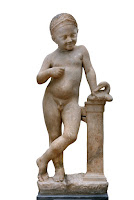During the past few years we've been observing the centenary of World War I, and now as we move toward the 100th anniversary of the Armistice next year, I'll share a few thoughts.
Here’s one, for example. Did you know
that the holiday we now call Veterans Day was originally called Armistice Day
for the very reason that it marked the anniversary of the Armistice that ended
the fighting in the First World War? The unfortunate intervention of several
other wars made the specific date of November 11 less relevant, so the name of
the holiday was changed to Veterans Day to honor those who had fought in all of
these conflicts.
Remembering that, this is a proper time
for further thoughts about Veterans Day and in this post I’m sharing thoughts not
only from me, but also links to two important essays I found during the past
week. And while I’ve not done many personal blog posts over the past few
months, sharing these essays seems like an appropriate opportunity for moving
back into my efforts with my personal blog.
Like many others, I was caught up in
the observance of the centenary, even from its early days back in 2014, or
perhaps even a little earlier. I read much about the war — and the lead-up to
the fighting — and my reading on the subject (which continues unabated) hasn’t
been particularly limited to either fiction or non-fiction. I’ve done both, reading
more books than I could count, I expect.
I also shared three posts as the
observance began, as it was my intention to continue sharing thoughts about the
Great War (as people in much of the rest of the world — especially in the U.K.
— refer to what we Americans call "WWI" or the “First World
War"). It was my goal to write about some of the things I've learned about
what went on during that amazing period in our history. And how what we learned
affected what we’ve become as a society.
But as I say. my own efforts got
side-tracked, and there wasn’t any long list of Guy’s WWI posts. There were
three, though, for anyone who wants to re-visit what I wrote about in my own
observance of the centenary at the end of 2014:
Guy’s Homage to WWI: Starting with “The
Piano in Wartime: 1914-1918” (December 11, 2014)
Guy’s Homage to WWI: The Very Fine
Exhibition at the New York Public Library December 22,
2014), describing “Over Here: WWI and the Fight for the American Mind”
Guy’s Homage to WWI: Holiday Greetings from
the Front (December 25, 2014), describing my little group of Three
World War I postcards I discovered when I lived in England.
And then yesterday came along, our day
of observance, and I spent much the day thinking about what the war meant to us,
as citizens so far removed from the time of the First World War and, quite
simply, as Americans. And no doubt I’ll continue thinking (and, yes, there will
probably be more posts from me on the subject). Why? Because I continue to be
inspired, and I want to share what I’m thinking about.
And among other inspirations, just Friday
I attended the memorial gathering honoring Thomas J. Fleming, a good friend and
very prolific author. Tom was, for me, one of the finest writers I’ve ever
known, and he wrote one of the best stories about WWI. It was a novel (Over There, published in 1992), and it
was a book that had quite an impact on me. Tom found some notes and stories
from his own father, and they sent him, as he put it once to me, “to the stacks
of the library to see what else I could find.” As it happened, when Over There was published the book was greeted
with much enthusiasm, and the book continues to find new fans (including myself
of course) as time goes on.
And now we move toward the actual
centenary of the Armistice, the agreement that ended the fighting on the
Western Front that went into effect on the eleventh hour of the eleventh day of
November 1918. And even though negotiations went on for six more months, the
Armistice did lead to the Treaty of Versailles of June 28 1919 which officially
brought World War I to an end.
We will observe the Armistice centenary
a year from yesterday, and while I won’t promise anything, I'll probably share
a few more thoughts between now and then. But in this post these thoughts are
not from me. As promised earlier, I’ve read two important essays that I want to
let friends and colleagues know about.
The first is an excellent essay from
the fine people at Foreign Affairs, What America Owes Its
Veterans: A Better System of Care and Support, by Phillip
Carter. The article offers a good history and analysis of our country's interactions
with its veterans. It’s a real “thought-piece” and well worth reading. And
thanks to the publishers Carter’s essay is a "paywall-free" article
from Foreign Affairs, so there's no charge to see this article (if
the live link doesn't work you can use https://goo.gl/WuFrTV to open this
article).
And if you have the chance, please also
read Ending DACA Will Hurt
Immigrant Troops, by Former Secretary of Defense Robert M. Gates. His
opinion piece provides much stimulating content for us on this Veterans Day
week-end (again if the live link doesn't open, please use https://goo.gl/RvQ4SY). In his
article, Former Secretary Gates relates how he believes we need legislation to
"provide a pathway to citizenship for those immigrants who, among other
attributes, are serving or have served in the military...." In light of
their service and sacrifice, he points out simply that "it is also the
right thing to do."
Something we might think some more
about in this final centenary year of the “war to end all wars.”


